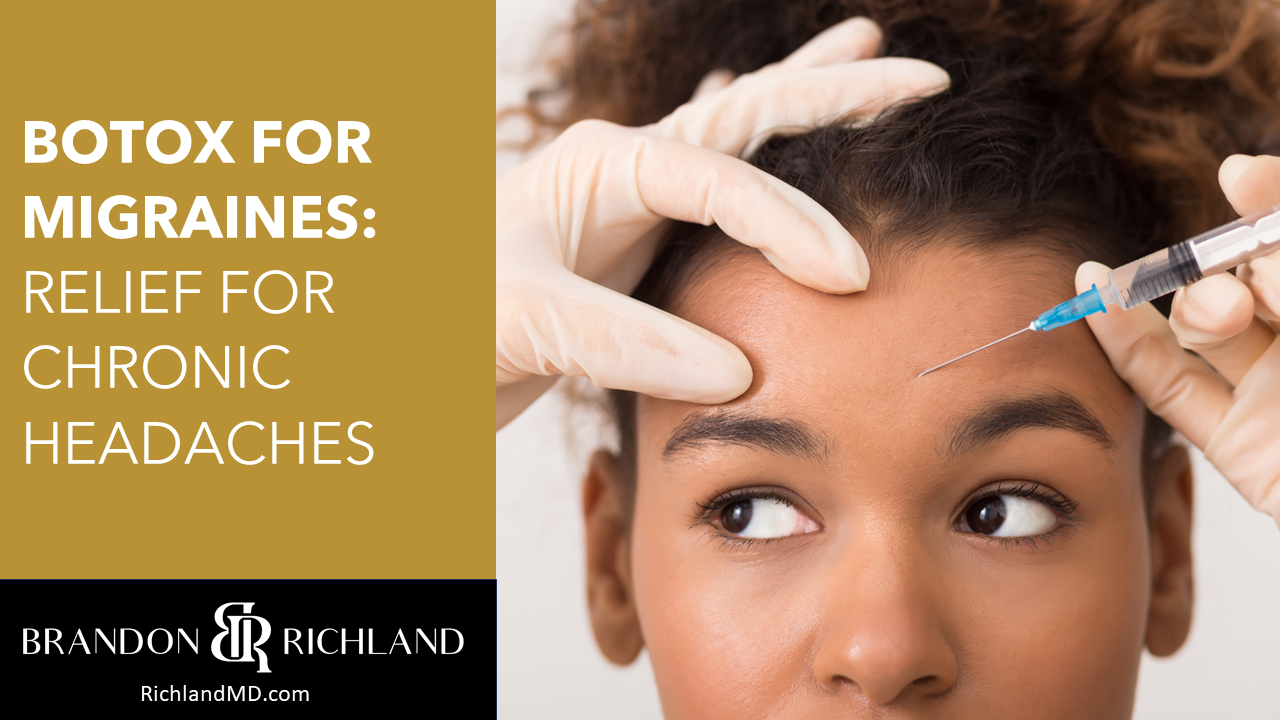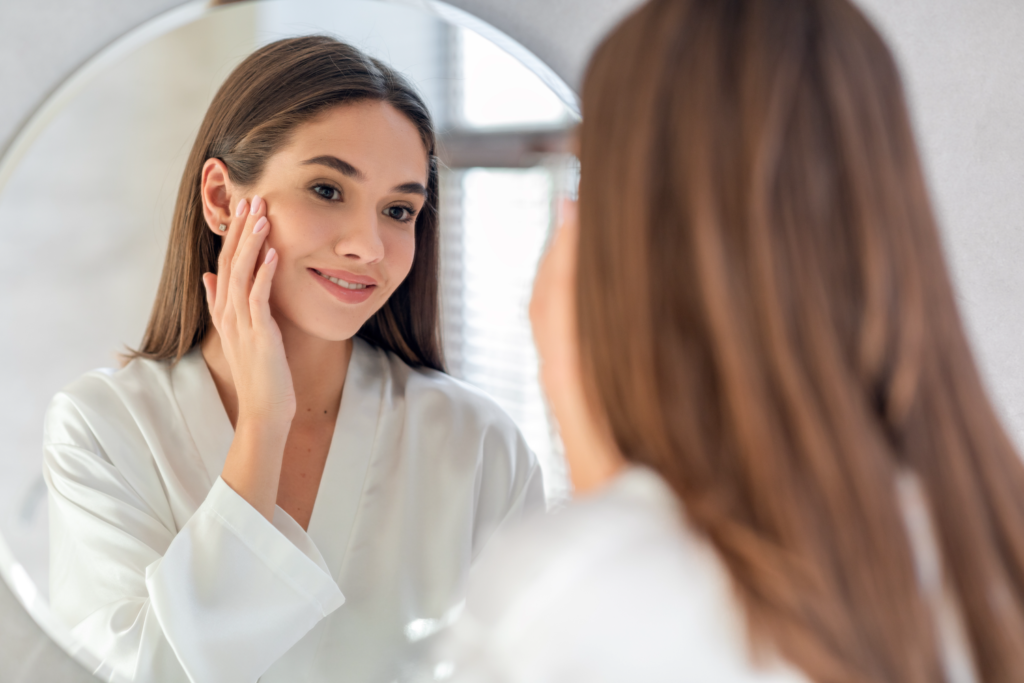Published by Dr. Brandon Richland, MD

Migraine sufferers are often on the lookout for effective treatments to alleviate their chronic pain. Among the various options, Botox, a neurotoxin known for its cosmetic benefits, emerges as a surprising but promising treatment for chronic migraine. It functions by blocking the release of chemicals involved in pain transmission, which, in turn, can prevent the onset of migraines.
Many adults with chronic migraines, defined as having more than 15 headache days per month, have found relief with Botox injections. Healthcare providers typically administer Botox every twelve weeks, involving multiple injections around the head and neck to dull future headache symptoms. While it’s not a cure, for many, it leads to a significant reduction in the frequency of migraine attacks.
Key Takeaways of Botox for Migraines
- Botox is used as a preventive treatment to reduce the frequency of chronic migraines.
- The treatment entails multiple injections around the head and neck area every twelve weeks.
- Patients considering Botox should be aware of the procedure details.
Understanding Botox and Migraines
Botox, a brand name for onabotulinumtoxinA, and migraines have been linked through a treatment that has brought relief to many chronic migraine sufferers. It directly addresses the excessive neurotransmitter activity that can contribute to chronic migraines.
Botox is a purified form of botulinum toxin, a neurotoxin produced by the bacterium Clostridium botulinum. It is widely known for its cosmetic use to reduce wrinkles, but it has also been approved by the FDA for treating chronic migraines.
When injected in small doses, Botox temporarily paralyzes muscles and blocks certain neurotransmitters, which can prevent headache symptoms from occurring.

Migraines Explained
Migraines are a type of headache characterized by intense pain, often accompanied by nausea, sensitivity to light, or visual disturbances known as aura. They are believed to involve hyperactive nerve cells that release neurotransmitters, causing inflammation and pain within the brain.
Chronic migraines are diagnosed when a person experiences headaches on 15 or more days per month. Botox injections for migraines are specifically targeted to reduce the frequency and severity of these headache episodes.
Botox for Migraine Treatment
Botox is not just a cosmetic treatment; it’s also an FDA-approved therapy for patients with chronic migraine headaches. When administered by an expert, Botox injections can provide significant relief from the frequency and severity of migraines.
Efficacy of Botox for Migraines
Botox injections can result in a significant decrease in the frequency of chronic migraine headaches. Patients undergoing this treatment have reported experiencing fewer days with migraines each month. Furthermore, Johns Hopkins Medicine highlights its status as a powerful option for those who have not found relief with other treatments.
The efficacy of Botox for migraines is contingent on proper administration, who will target specific areas associated with migraine pain.
Botox Injection Sites for Migraines
Botox for migraines is targeted through specific injection sites that are strategically chosen to manage the muscle activity associated with chronic migraine pain.
Forehead and Temples
The forehead and temple areas are common sites for Botox injections to alleviate migraine-related discomfort. Patients typically receive injections in the frontalis muscle of the forehead, distributing approximately 20 units of Botox across four sites.
The temples are also treated, often including the corrugator muscle, which can contribute to tension and ultimately migraine pain when overactive.
Neck and Shoulders
To reduce neck pain and tension that can lead to migraines, Botox is administered in the muscles of the neck and shoulders. Injections are usually placed in the cervical muscles that cover the back of the head and neck, extending down to the shoulders.
Precisely targeting these muscles aims to diminish the chronic muscle activity that often plays a role in triggering migraine episodes.
Insurance and Cost Considerations
When considering Botox as a treatment option for migraines, it’s essential to understand the financial aspects, including insurance coverage and out-of-pocket expenses.
Insurance Coverage for Botox
Most insurance companies recognize Botox as a preventive treatment for chronic migraines. However, they often have specific criteria patients must meet before they will provide coverage.
Typically, insurance coverage is contingent upon the patient having a diagnosis of chronic migraine, which is defined as having 15 or more headache days per month with migraines on at least 8 of those days. If a patient’s medical history aligns with these criteria, insurance may cover the cost of Botox treatments, usually every three months.
- Medicare: Often includes Botox under its benefits, treating it as a low-cost option that can reduce the overall costs related to migraine care.
- Private insurance: Coverage varies by plan, but many have policies in place for Botox when used for chronic migraine prevention.
Patients should contact their insurance provider directly to understand their coverage details, as policies and prerequisites may vary greatly.
Out-of-Pocket Costs
For those without insurance coverage or who have not met their deductible, Botox treatments can pose a significant out-of-pocket expense. The cost depends on the number of injections and sessions required which generally means undergoing multiple treatments every few months. Prices can vary by location and provider, but they can reach several thousand dollars per treatment session.
Patients should also explore assistance programs and financing options through their healthcare provider or manufacturer, as these can help manage the high upfront costs of Botox treatments for migraines.

Botox Treatment Success and Follow-up
When assessing the success of Botox for migraines, it is critical to monitor changes in headache days and to adhere to a structured treatment plan. Consultation with a specialist can ensure accurate evaluation and appropriate scheduling of follow-up appointments.
Measuring the Effectiveness of Botox
Assessing the effectiveness of Botox treatment involves tracking the reduction in the frequency and intensity of headache days.
Patients typically report a decrease in pain signals and migraine symptoms within two to three weeks after treatment. Consistency in treatment results is often seen after multiple sessions, with some patients experiencing significant reductions in migraine days.
The response to Botox can vary, and it is important to maintain open communication with a specialist to evaluate the treatment’s impact accurately.
Scheduling Follow-up Appointments
Follow-up appointments are essential to a successful treatment plan for chronic migraines. They should be scheduled:
- Every 12 weeks, as the effects of Botox may wear off after about three months.
- Sooner if a patient experiences any unexpected side effects or changes in their condition.
At these appointments, a healthcare provider can:
- Reassess the patient’s response to Botox.
- Determine if adjustments to the treatment plan are needed.
- Discuss any concerns the patient might have, ensuring continuity of care.
Regular follow-up is crucial to tailor the treatment to the patient’s evolving needs.
Frequently Asked Questions About Botox for Migraines
1. Can Botox Treatments for Migraine Relief Affect Facial Appearance?
Botox, when used as a treatment for chronic migraines, is typically injected into muscles of the forehead, neck, and shoulders, which could lead to a reduction in wrinkle formation in those areas over time.
2. What Are The Potential Side Effects When Using Botox to Treat Migraines?
Patients may experience side effects like redness, soreness, or swelling at the injection site, bruising, chills, fatigue, dry mouth, and neck stiffness following Botox injections.
3. What Criteria Must One Meet To Be Considered a Candidate for Migraine Treatment with Botox?
To be a candidate for Botox treatment for migraines, an adult must have a history of migraine headaches and experience them on most days (at least 15 or more per month) lasting 4 hours a day or longer.
4. How Can I Have My Migraine Botox Treatments Covered by Health Insurance?
Coverage for Botox migraine treatments may be possible if the patient provides documentation of chronic migraine history and demonstrates that other treatments have not been effective. Consulting with one’s insurance provider is a necessary step to understand specific coverage options.
5. What Is The Expected Duration of Relief from Migraines After Botox Injections?
While individual results may vary, many patients report experiencing relief from migraines for up to three months following Botox treatments.
6. How Effective Is Botox in Reducing Migraine Frequency and Severity?
Botox has been proven to effectively reduce the frequency and severity of migraines in numerous patients, particularly those who experience chronic migraines, with some studies showing significant improvement in their symptoms.

Conclusion and Summary of Botox for Migraines: Relief for Chronic Headaches
Botox, scientifically known as onabotulinumtoxinA, has transcended its popular use for cosmetic purposes such as treating facial wrinkles, to become a well-tolerated and effective treatment for various medical conditions, including migraine headaches. Approved by health care professionals, Botox injections target the shallow muscles and nerve endings that carry pain signals, which are implicated in the development of severe headache pain.
The use of Botox to relieve migraine pain operates on the premise that it can inhibit the release of calcitonin gene-related peptide and other substances involved in migraine pathways.
Furthermore, Botox is used to address other neurological and muscular disorders such as cervical dystonia, hemifacial spasm, and cerebral palsy, showcasing its versatility. While it is primarily prescribed for chronic migraine, its applications extend to episodic migraine and even tension-type headache under certain diagnostic criteria.
Despite concerns over medication overuse headache, the treatment is generally well tolerated, with the most common side effects being transient and manageable. Overall, Botox represents a pivotal advancement in the arsenal of headache specialists, providing relief for patients who may not have responded adequately to traditional medications.
Please note that this article is intended for informational purposes only and should not be construed as medical advice. Before making any changes to your treatments, please consult with your healthcare provider to discuss the appropriateness and safety of such changes.
Ready For Your First-Class Cosmetic Experience in Orange County (OC) California (CA)?
Are you located in one of these Orange County (OC) / Southern California cities?
Aliso Viejo, Anaheim, Brea, Buena Park, Costa Mesa, Coto de Caza, Cypress, Dana Point, Fountain Valley, Fullerton, Garden Grove, Huntington Beach, Irvine, La Habra, La Palma, Laguna Beach, Laguna Hills, Laguna Niguel, Laguna Woods, Ladera Ranch, Lake Forest, Los Alamitos, Mission Viejo, Newport Beach, Orange, Placentia, Rancho Santa Margarita, San Clemente, San Juan Capistrano, Santa Ana, Seal Beach, Stanton, Tustin, Villa Park, Westminster, or Yorba Linda?
Plastic Surgeon Dr. Brandon Richland, MD and our Cosmetic Aesthetics Team are ready to help you look and feel your absolute best.
Elevate your confidence and self esteem levels to unfathomable new heights!
Schedule your in-person consultation in our modern and luxurious offices in either Fountain Valley, CA (Main HQ) or our Newport Beach, CA office.
Do you live outside of Southern California or short on time? For your convenience, Virtual Consultations are also available.
Our warm and engaging Team of carefully selected Aesthetics Professionals will make you feel calm, cool, collected, and right at home throughout your entire consultation and surgery process.
Schedule Your Aesthetics Consultation here, or call us directly at 949-867-4496 today.
About the Author

Dr. Brandon Richland, MD is a respected Board Certified Licensed Plastic Surgeon in Orange County / Southern California specializing in cosmetic and reconstructive surgeries.
Driven by his passion for medicine, Dr. Richland obtained his Doctor of Medicine (M.D.) degree from the prestigious program at Saint Louis University (SLU) School of Medicine in 2013. His exceptional skills were recognized when he received the McGraw Hill / Lange Medical Student Academic Achievement Award, and graduated top of his class with Honors. For his undergraduate degree, he attended University of California, Los Angeles (UCLA) and graduated with Honors in 2009.
To further enhance his surgical expertise, Dr. Richland completed his Residency in Plastic Surgery at the University of California, Irvine (UCI) from 2013 to 2019 earning the Academic Achievement Award twice during this period. A total of 14 years in dedicated schooling and medical residency.
Dr. Richland is actively involved with healthcare and medical societies, as a Diplomate of the American Board of Plastic Surgery, a member of the American Society of Plastic Surgeons, American Society of Aesthetic Plastic Surgeons, and the California Society of Plastic Surgeons.
Contact Dr. Richland today by visiting RichlandMD.com, scheduling a cosmetic consultation, or by calling 949-867-4496 directly.
Cover Image Credit: Milkos / 123RF.com (Licensed). Photo Illustration by: Dr. Brandon Richland, MD.










